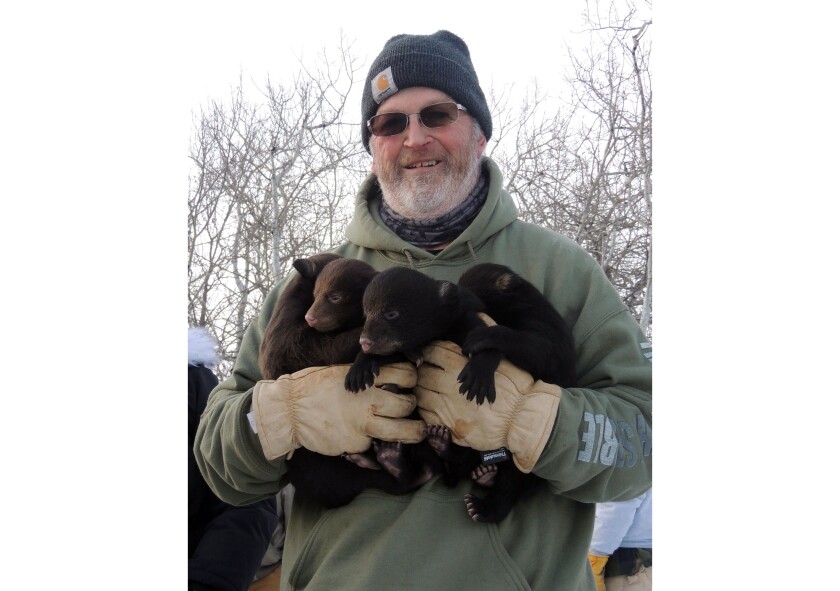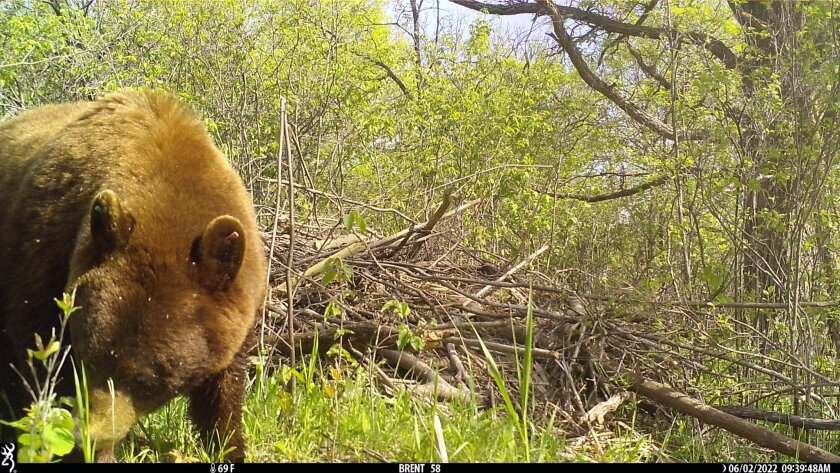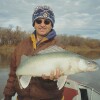PLUMMER, Minn. — Around these parts, she’s known as the “Plummer Bear,” and Brent Hemly admits he was beginning to worry a bit that something might have happened to the sow, who’s now 13 years old, when she didn’t show up right away this spring on one of his trail cameras.
Hemly, who calls his trail camera hobby an “addiction,” needn’t have worried.
The Plummer Bear is alive and well in Red Lake County, and — get this — she has four cubs.
“I knew she should have cubs this spring,” Hemley said. “When I found her, I was pretty excited — just for the fact that she’s still alive and then to get the picture of the cubs. You get a lot of people who are interested in that — and in my head, it helps protect her somewhat.”
Hemly, of Plummer, first got a glimpse of the sow June 2, when she showed up on one of his trail cameras. He knew it was the Plummer Bear because he could make out the number “4087” on her ear tags, but the close-up image didn’t reveal any cubs.
ADVERTISEMENT
That made him wonder.
“The camera wasn’t set up for bears,” Hemly said. “I had it set up for something else, and I got her right there in the front with the ear tag. I knew she was alive.”
Long history

Hemly and the Plummer Bear go back several years. He first live-trapped her “in 2011 or 2012” while assisting the Department of Natural Resources on a comprehensive research study of black bears in northwest Minnesota, which lies on the fringe of traditional black bear range.
As part of the study, DNR crews fitted the Plummer Bear with a GPS collar and ear tags to monitor her whereabouts.
She’s had five sets of cubs over the years, Hemly says — three in 2013 and three in 2015 before losing a set of cubs and switching to an even-yeared breeding schedule.
She then had four cubs in 2018, four cubs in 2020 and four more this year.
The northwest Minnesota bear study wrapped up in 2020, and while the Plummer Bear no longer sports a GPS collar, she does have numbered ear tags with the number “4087.”
ADVERTISEMENT
The assumption, Hemly says, is that she was born in 2009, “just by the size of when I live-trapped her,” although that’s just a guess.
During the course of the DNR study, Hemly live-trapped five bears in the Plummer area, including three that were fitted with tracking collars. He also worked as a liaison, of sorts, between the research crew and local landowners to get permission to access private land where bears were denning.
Trail cam success
Those local connections led Hemly to ultimately find the Plummer Bear with her four cubs earlier this month. The sow stands out with her cinnamon-colored coat.
It all started, Hemly says, when a nearby landowner told him he’d seen a sow with four cubs but couldn’t tell the color because it was late in the day. The next day, another landowner nearby shared a daytime photo he’d taken of a cinnamon-colored sow with four cubs, one of which is nearly blond.

Hemly says he set “a bunch of cameras” at both sites — he owns about 50 trail cameras, though he doesn’t have all of them out at the same time — ultimately getting images of the sow with her four cubs. He knew it was the Plummer Bear by the ear tags, and not a similarly colored sow that also roams the fields and forests near Plummer.
Unfortunately, none of the trail camera images show all four cubs.
“I had a picture of all four cubs in one picture and wouldn’t you know, I deleted it” by mistake, Hemly said. “I thought I saved it, and I hadn’t. Anyway, I went through the pictures, and she’s got two darker cubs and two light cubs.”
He posted photos on Facebook, including one photo clearly showing the sow has two green-colored ear tags. Getting the trail camera images was worth the effort, despite nearly getting eaten alive by mosquitoes and black flies, Hemly says. He now has pulled most of his cameras because the area is so wet and difficult to reach.
ADVERTISEMENT
“Later on, I would imagine, as we get back into August and September, I’ll get cameras back out and I’ll catch her with a little bit bigger cubs, and I’ll see how they did for the summer, assuming they all make it,” Hemly said. “I’m assuming they will.”
Hemly, who admits he didn’t know “diddly” about bears when he began assisting the DNR with the project, says he learned cubs in northwest Minnesota tend to weigh more than cubs in the wooded country farther east in more traditional bear range.
Bears in the northwest also tend to produce more cubs than bears in more forested areas, said Andy Tri, bear project leader for the DNR in Grand Rapids, Minnesota.

Four-cub litters are uncommon, but 13% to 14% of the sows in northwest Minnesota have four cubs, Tri said, “whereas in all of our other study areas they are quite rare.
“They are still uncommon in northwest Minnesota, but much more common there than elsewhere,” he said.
In addition, the fattest bears tend to be found in the northwest, along with the ag-forest transition zone near Little Falls and Brainerd, Tri said.
That’s a function of the abundant oak forests and crops such as corn, which are less common in more traditional bear range farther east in Minnesota, Tri said. On average, females sampled in March are at least 50 pounds heavier at age 5 – the average age at which they have their first cubs – than bears in primary bear range, Tri said.
The Plummer bear definitely finds Red Lake County to her liking, Hemly says, because her home range is only about 5 miles by 3 miles, “give or take,” based on the DNR’s years of tracking her.
ADVERTISEMENT
“I call her kind of a corn pig because as soon as she finds a cornfield (she likes), she’ll camp right in that cornfield, which puts on all the fat she needs for the winter,” he said.
Fun to follow
Local farmers have been “really good” about tolerating the Plummer Bear, Hemly says. He dubbed her the Plummer Bear rather than just 4087 to give her some notoriety and to spur local interest, which has been considerable, in protecting her.
The recent photos he shared on Facebook have been a big hit, Hemly says.
“Don’t get me wrong, I hunt and all that good stuff but it’s just interesting to follow her,” he said. Many local farmers now give bear hunters permission to hunt their land as long as they don’t shoot the Plummer Bear, Hemley says.
Telling her apart from other bears was easy during the study, Hemly says, because of the tracking collar and big orange ear tags. The ear tags she has now are green and much smaller, so they’re harder to see, he says.
“She’s a colored bear so you get a hunter that says, ‘I want to shoot something different,’ and there’s a big, colored bear,” Hemly said. “That’s why when I put it on Facebook, there’s two reasons for it — the other part is that you get enough people following it, especially ladies, they’ll tell their husbands, ‘Don’t you dare shoot that bear.’ And if you’re a local, you don’t want to be the one who shot the Plummer Bear.”
Hemly says he’s learned another thing about the Plummer Bear over the years: she doesn’t like trail cameras.
“Just this spring, she busted the back out of two of my cameras,” Hemly said. “She’s hell on cameras.”










